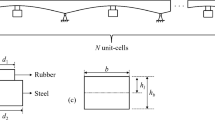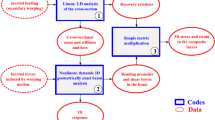Abstract
The problem of wave transmission between two finite beams joined by a cross beam welded between them is solved taking full account of longitudinal and flexural waves in all the beams. Prediction of longitudinal and flexural wave transmission through the “T” joints in the beam system was performed over a wide band frequency range. The wavenumber-frequency spectrum was used to separate the wave types based on their different dispersive characteristics. Flexural direction forces at one end of the beam system were examined. The experimental data were taken using an accelerometer array and a simultaneous twenty-three channel measuring system. A transfer function correction technique was employed to account for the instrumentation errors. Experimental results were confirmed by the finite element analysis results. The total mean squared vibrational energy levels were calculated in each section of the beam system to quantify the transmission characteristics of both flexural and longitudinal waves passing through the beam joints.
Similar content being viewed by others
References
Bhattacharya, M. and Mulholland, K., 1971, “Propagation of Sound Energy by Vibration Transmission via Structural Junctions,” J. Sound Vib., Vol. 18, pp. 221–234.
Blake, W. and Chase, D., 1971, “Wavenumber-Frequency Spectra of Turbulent Boundary Layer Pressure Measured by Microphone Arrays,” J. Acoust. Soc. Am., Vol. 49, No. 3, pp. 862–877.
Bull, M., 1967, “Wall-Pressure Fluctuations Associated with Subsonic Turbulent Boundary Layer Flow,” J. Fluid Mech., Vol. 28, pp. 719–754.
Cremer, L., Heckl, M. and Unger, E.E., 1973,Structure Borne Sound, Springer Verlag, Berlin, p. 280.
Doyle, J. F. and Kamle, 1987, “An Experimental Study of the Reflection and Transmission of Flexural Waves at an Arbitrary T-Joint,” J. Appl. Mech., Vol. 54, pp. 136–140.
Hodgson, T. and Keltie, R., 1984, “An Innovative Fast Fourier Transform Array Technique for Low Wavenumber Measurements of the Turbulent Boundary Layer Fluctuating Pressure Field,” Symposium on Flow-Induced Vibrations, Vol. 5, pp. 39–51.
Gaul, L., 1983, “Wave Transmission and Energy Dissipation at Structural and Machine Joints, Trans. ASME, Series L, Vol. 105, pp. 489–496.
Lyon, R., 1975,Statistical Energy Analysis of Dynamic Systems. The MIT Press, Massachusetts.
Maidanik, G. and Jorgensen, D., 1967, “Boundary Wave-Vector Filters for the Study of the Pressure Field in a Turbulent Boundary Layer,” J. Acoust. Soc. Am., Vol. 42, No. 2, pp. 494–501.
Rosenhouse, G., 1970, “Acoustic Wave Propagation in Bent Thin-Walled Wave Guides,” J. Sound Vib., Vol. 67, pp. 469–486.
Wills, J., 1970, “Measurements of the Wavenumber/Phase Velocity Spectrum of Wall Pressure beneath a TBL,” J. Fluid Mech., Vol. 45, pp. 65–90.
Yoshimura, M., 1977, “Measurement of Dynamic Rigidity and Damping Property of Simplified Joint Models and Simulation by Computer,” Annals of the CIRP, Vol. 25, No. 1, pp. 193–198.
Yoshimura, M., 1979, “Computer-Aided Design Improvement of Machine Tool Structure Incorporating Joint Dynamic Data,” Annals of the CIRP, Vol. 28, No. 1, pp. 241–246.
Author information
Authors and Affiliations
Rights and permissions
About this article
Cite this article
Oh, S. Wave transmission at discontinuities using wavenumber-frequency techniques. KSME Journal 7, 272–281 (1993). https://doi.org/10.1007/BF02970971
Received:
Issue Date:
DOI: https://doi.org/10.1007/BF02970971




